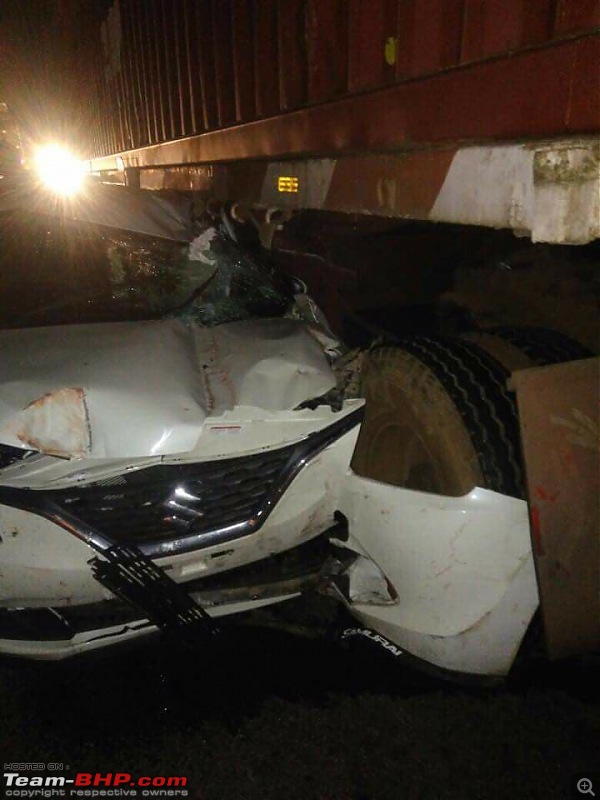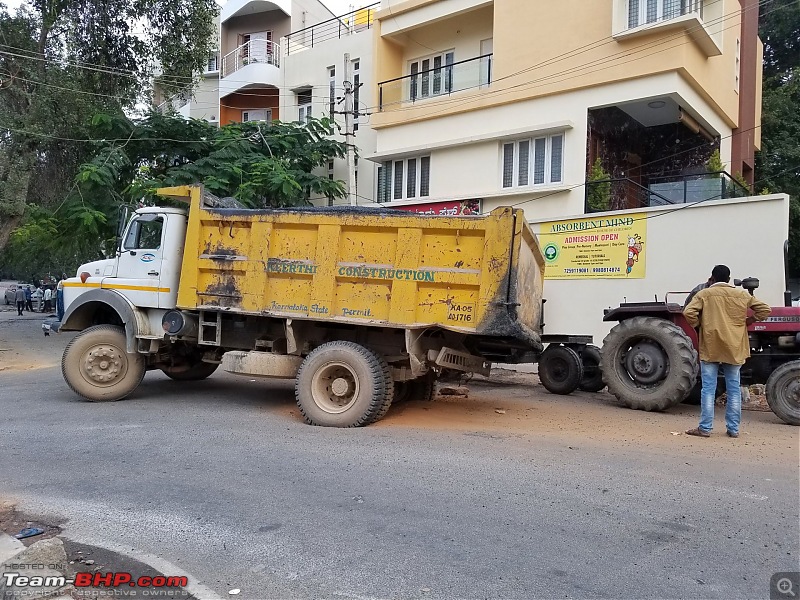Team-BHP
(
https://www.team-bhp.com/forum/)
-
Road Safety
(
https://www.team-bhp.com/forum/road-safety/)
Quote:
Originally Posted by swissknife
(Post 4294940)
I wonder why the bus driver could not shift gears and stop / stall the bus rather than plough through!
|
That comes with common sense and skill training which unfortunately are lacking in most of the heavy vehicle drivers.
On the other hand, these simple hacks are easily said than applied. In reality, I guess most people would panic and tend to do nothing fruitful unless they are naturally quick-witted or trained well to tackle emergency situations.
Is it not possible to introduce hand brake in heavy vehicles ? I have read some where that hand brake will be available in buses and trucks as well. Is this not in India ? I really wonder whether the drivers of heavy vehicles will be trained on how to make use of hand brake in emergency.
A couple of years ago, I have seen a message written on a government bus dash board : "Driver Saab, this bus is equipped with hand brake. Please make use of it when ever necessary".
Sorry, for being off topic but couldn't hold myself. Surprising to see so many accidents happening with this level of awareness..! :D
Quote:
Originally Posted by Hickstead
(Post 4294961)
Is it not possible to introduce hand brake in heavy vehicles ? I have read some where that hand brake will be available in buses and trucks as well. Is this not in India ?
|
Hand brakes are very well available in heavy vehicles as well (across the globe), but on a panic situation hardly that comes in mind.
Quote:
Originally Posted by Mr.Boss
(Post 4295002)
Hand brakes are very well available in heavy vehicles as well (across the globe), but on a panic situation hardly that comes in mind.
|
Heavy vehicles all have air brakes.
These work in the exact opposite way your car's hydraulic brakes work.
In a car the brake shoes are held back from the drum or disc by springs. When you apply the brake, the spring expands and the shoe rubs against the rotating drum.
In air brakes, the shoes are jammed tight against the drums by springs. That is the default setting.
Why?
They get released due to the air in the air cylinders. That's why you see drivers releasing or emptying the air cylinders when they plan to halt a long time. No point in stressing your air cylinders.
At this point, the shoes are jammed tight against the drums by the springs, You can do this on a slope if you like. The truck or bus will not move.
When you start the bus, you wait a minute or two for the air cylinders to get filled.
That's why you only need to cough on an air brake, and the vehicle will stop. Obviously not immediately, as the inertia of motion has to be considered.
Try driving a Leyland or tata LPT chassis and touching the brake. It will immediately lock the wheels as it is just a ladder frame and engine. Negligible weight.
Old trucks only had one air big cylinder. I've seen a few new Canters with 4 mini cylinders. It could be just over engineering. Or building multiple redundancies.
Oh yes!!!
Takes me back to my first Heavy Vehicle Driving class. Yes I do have a Heavy Licence for both Goods and Passenger vehicles along with an auto rickshaw licence and Yellow Board Badge thrown in for good measure along with the regular two and four wheeler.
Back to my first day behind the wheel of the Driving School Bus -
The young 21 year old me had done all the homework about the bus I was going to drive. One thing from the specs that stood out was
"Drum Brakes".
Coupled with the ever familiar sight of our buses taking a long time to come to a halt with the brakes squealing away and with my experience of driving with non assisted brakes on the 800 I had imagined the brake pedal to require a firm stomp for the bus to stop.
I was in for a rude awakening.
The empty bus stopped on a dime and I not being restrained by seatbelts was nearly thrown out of the drivers seat.
I never imagined the stopping power to be so immense.
I went back home and read up more about "air brakes"
Quote:
Originally Posted by Mr.Boss
(Post 4295002)
Hand brakes are very well available in heavy vehicles as well (across the globe), but on a panic situation hardly that comes in mind.
|
Yes handbrakes are available for heavy vehicles and YES in panic situation they do come to mind, HOWEVER it will come to mind only when you are trained to use it and trained well enough to pass your driving test.
I am a witness to the use of handbrake on all London buses and a couple of occasions on heavy vehicles. The London bus drivers will use the handbrake at each and every time the bus stops, traffic signal, pedestrian crossing or bus stop.
Remember though we are all humans and accidents will happen but if there was a handbrake the innocent lives could be spared.
Since it has already been discussed wont discuss on our flaws of driving, licensing, safety equipment on all other vehicles, except Cars :(
Rest in peace
In the APSRTC brake failure video, there was a truck jutting out waiting to take a turn. If the bus driver had known the brakes had failed before that point, he could have rammed one side of the bus onto the truck and stopped. Instead of fatalities, there would have been only injuries.
Of course thinking on the feet from a driver who just realised he lost brakes is difficult.
Quote:
Originally Posted by hangover
(Post 4295020)
Try driving a Leyland or tata LPT chassis and touching the brake.
|
Thanks for the explanation, but I have a decent experience with heavy vehicles (of almost every brand that is sold in India) in driving as well as design & development and sufficient knowledge in brake system of both pneumatic and hydraulic type.
I know your explanation will help fellow members and readers here, but you could have quoted the initial post and not mine (your explanation has minimal accordance with my post)
Fender bender on the hebbal flyover towards palace grounds today afternoon. There was heated argument going on and as usual the cabbie was arguing that it was not his fault.
Quote:
Originally Posted by hangover
(Post 4295020)
Heavy vehicles all have air brakes.
They get released due to the air in the air cylinders. That's why you see drivers releasing or emptying the air cylinders when they plan to halt a long time. No point in stressing your air cylinders.
|
Is this the reason why busses and trucks make "shooo" "shoo" sound as if the vehicle is sneezing. I always wonder what could be that sound but it surely is air that comes out with force. I think your explanation is the answer to this.
A Baleno rear ended a truck at night. No info about the passengers.


 Source:
Source: Facebook
When hunter becomes hunted.
Saw this truck loaded with tar near banashankari 2nd stage post office in Bangalore.
It's loaded with tar for a road repair work in the next road and it is now sunk in a pothole. The pothole was earlier filled because the area was weak.

Quote:
Originally Posted by Leoshashi
(Post 4295922)
A Baleno rear ended a truck at night. No info about the passengers.
|
More than a rear ending, it looks like the truck moved to the right while the Baleno was trying to overtake it (at a speed where it was too late to take evasive or corrective action).
The Baleno is sandwiched under the middle section of the right side of the truck. There are very few ways how a car can end up there
Quote:
Originally Posted by selfdrive
(Post 4297733)
The Baleno is sandwiched under the middle section of the right side of the truck. There are very few ways how a car can end up there
|
It's a real puzzle this one.
The mud flap suggests that the truck or trailer and the car are facing opposite directions. Although a few will have flaps at both ends of the wheel as well.
If this is true then, the Car is on the wrong side of the truck. Let's leave this option out as it is too weird to comprehend.
If it is false then its an overtaking manoeuvre gone horribly wrong with the car having to take a chance refuge under the trailer.
But if all that is indeed true then what are the rust marks on the bonnet? It could only be another truck or large vehicle going in the same direction. Anything hitting the car from the opposite direction would have sheered the car in two halves.
Best assumption would be a long trailer on the left and the car tried to make a dash for a left side overtaking of another truck, either before or right after the tractor part had passed, little realising that there was more of that vehicle above the window or eye level.
| All times are GMT +5.5. The time now is 18:06. | |


